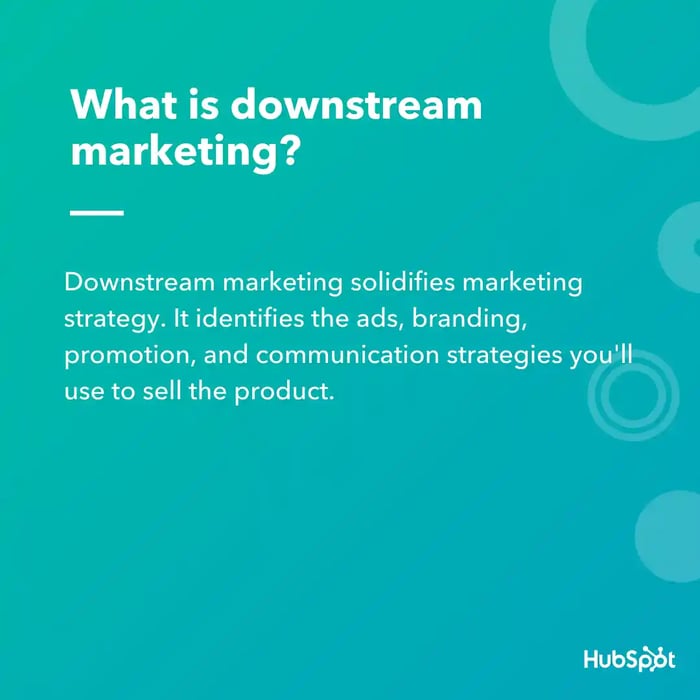You’re probably here for the same reason. So, let’s talk about the difference between these two terms and how they work together. Are you ready for a quick introduction to upstream and downstream marketing?
Upstream Marketing
Upstream marketing is a long-term plan. It allows for marketers to conceptualize a timeline for future releases based on customer segments. To create an upstream marketing plan, start with a section of your audience that you want to focus on in the next year or so.

Your completed upstream plan should include the following:
- Identification of a portion of your audience's problems
- A product or service that will solve those challenges
- A price and competitive edge for campaign assets
First, identify the challenges your customers are facing. Do this by referring to your buyer persona and researching the current market as well as gathering feedback from current customers.
For instance, let's say your company offers a CRM and your team decides to use an upstream plan for improving the enterprise-level tier of offerings. The first step is to identify consumers' pain points. After analyzing market and feedback data, you find that enterprise customers want software that will simplify testing campaign assets.
Enterprise-level customers need sophisticated, scalable software that enables them to analyze campaigns and engagement metrics. You and your team decide that's where your new product is going to come in — it will focus on helping customers analyze campaigns that are impactful.
You decide on adding an adaptive testing feature to your CRM. It first will allow customers to automatically test web page performance for metrics like click-through rate, conversions, and session time. They can use that data to improve the effectiveness of those pages.
With the challenge and solution figured out, think about how much the tool will cost and how it can be set apart from the market. If you included competitor data in your research process, you can refer to it at this step to strategize your product's market edge.
This strategy looks similar to deciding on a price. Factor in your customer segment, competitor pricing, and your own pricing model. With this information, you ultimately decide that the tool will be an add-on to your existing enterprise tier, and the marketing edge will be that the service is a complementary update.
Conceptualizing a product, its price, and its competitive edge sounds like it would happen pretty early on in the marketing process, right? It is, and, in fact, it should be done before considering downstream marketing. Upstream marketing helps companies plan roll-outs by providing a bird's eye view of what can be expected in the long-term.
Now, you've come up with the who, what, when, where, why, and how. An adaptive testing feature will be added for enterprise-level customers within your company's CRM within the next year. The marketing strategy will focus on its increased value for the enterprise tier.
With this plan in place, you can solidify a downstream process.
Downstream Marketing
If upstream marketing is the "big picture" planning session, downstream is the game plan. So, for the CRM company, the next step is to come up with a campaign strategy. That process involves downstream marketing.

Downstream marketing is more short-term than upstream marketing. It strategizes marketing campaigns and asks the question, "What resources can we leverage to make the customer want our product?"
Sometimes, downstream is used interchangeably with general marketing practices: Coming up with processes and activities that will effectively communicate the value of a product or service. This isn't wrong.
Because the upstream process identified the product, its price, and its competitive edge, the downstream method can use this information to produce an informative, engaging campaign.
Your CRM company, at this point, will now have to decide the framework for your adaptive testing campaign. Think about what social media channels you will leverage, the angle of the promotional video, and offers you may want to draft. Decide how you will communicate the release of your updates to customers and leads.
For instance, in this step, you may decide to use LinkedIn Ads, email marketing, and an ebook offer. These channels will be used to acquire leads, excite existing customers, and explain how the update adds value to the existing product.
Upstream Marketing vs. Downstream Marketing
When upstream and downstream work together, the result is a smooth product development cycle that keeps marketing in mind. The two help you build the bones of a campaign at an early stage.
Let's go back to the CRM company example. You used upstream marketing to come up with a product of value for your existing customers. It helped you to identify its market edge and campaign cycle.
Then, using downstream marketing, you developed a framework for the overall marketing strategy. You decided which channels would reach enterprise-level customers effectively. You decided how branding will play a part in solidifying the growth of your product, and how to shape messaging that will connect to your audience.
The two can create focused campaigns because they identify a customer segment, challenge, and benefit to be used for effective messaging. It keeps teams on the same track, even if the upstream ideas have to change.
For the long-term, what are some of the ways you plan to use both in future planning?
Marketing Strategy
.png?width=112&height=112&name=Image%20Hackathon%20%E2%80%93%20Vertical%20(46).png)


-Dec-04-2025-05-17-34-7864-PM.webp)




![The state of inclusive marketing in 2025 [new data + expert insight]](https://53.fs1.hubspotusercontent-na1.net/hubfs/53/inclusive-marketing-report.webp)
![How marketers are navigating a possible recession (and advice about what you should do during it) [new data]](https://53.fs1.hubspotusercontent-na1.net/hubfs/53/image12-May-27-2025-02-18-19-8390-AM.png)


